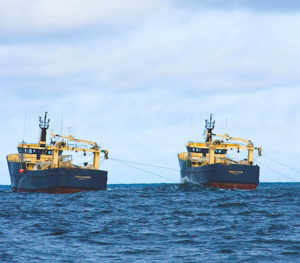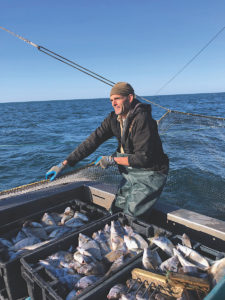The National Oceanic and Atmospheric Administration (NOAA) moved to protect herring on Nov. 19 when it approved a new rule restricting the operation of trawlers.

Amendment 8 to the Atlantic Herring Fishery Management Plan, developed by the New England Fishery Management Council over the past several years, prohibits the use of mid-water trawl gear year-round within 12 miles of the shore from Maine to Rhode Island and within 20 miles off the Cape. The amendment also proposes biological catch rules that account for herring’s role in the ecosystem and scientific uncertainty about stocks.
NOAA Greater Atlantic Region Communications Team supervisor Allison Ferreira told the Independent that the new rule will likely be published by the end of this year, and that restrictions, including buffer zones, will be implemented sometime early next year.
Cape Cod Fisheries Trust director Seth Rolbein said he is thrilled with the news. “This is the biggest, most important thing to happen from a regulatory point of view in a long time,” he said. “It’s a profound help to our small boat fleet and herring runs.”
Fisherman Kurt Martin of Orleans is also optimistic and said that the ruling will prevent overfishing. “It’s a huge win for small boat fisheries and everything that feeds on herring,” he said.

Cape Cod fishermen have noticed a decrease in herring stocks over the past two decades. During this same period, an increasing number of mid-water trawlers from Gloucester and New Bedford have been fishing off the Cape’s east and southeast shores. Advocates for tighter regulation argue that mid-water trawlers, with their large quantity of bycatch, are to blame for the collapse of herring stocks.
Rolbein hopes the amendment will result in their recovery, with economic benefits to the fishing industry. “We’re hoping to see a rebuilding of an ecosystem, which supported a small boat commercial fleet for generations,” he said. Rolbein thinks the return of the river herring run could draw tourists, too.
The ruling comes after 15 years of effort by fishermen and environmental advocates.
Rolbein said that two key factors pushed the amendment toward approval this year. First, communities across New England came together to support it. “Every town in Barnstable County endorsed it,” Rolbein said. Support came, too, from environmental groups and conservation trusts, he said. Amendment 8 received 275 public comments, the vast majority of them supportive.
Second, recent scientific reports painted a more dire picture of herring stocks than previously imagined. “Once it became clear that the stocks had crashed and that we had reached a crisis moment, everyone coalesced around the idea that we had to do something,” Rolbein said.
Indiscriminate Trawling
Mid-water trawlers work in pairs, dragging between them a net the size of a football field that sweeps up everything in its path. Although the net is supposed to stay in the middle of the water column — neither fishing at the surface nor scraping the bottom –– Rolbein said that nets often drift up and down. A pair of mid-water trawlers working together for many hours a day can cover a lot of territory, and, Rolbein said, “wipe everything out.”
On the other hand, fishermen working on small boats can be more selective and bycatch typically survives. “It’s a very different kind of fishing that doesn’t do much damage to the stock or to the bottom,” Rolbein said.
Trawlers are not new to the Cape. In the 1960s and ’70s, foreign vessels overfished Cape Cod’s waters, threatening herring stocks. But the exclusive economic zone was established under President Reagan in 1982, preventing foreign vessels from fishing within 200 miles of the U.S. coastline. Soon herring stocks recovered and the larger fish that fed on them became plentiful again.
Martin fished out of Provincetown in the late 1980s and still remembers the abundance of herring. “We saw so much herring every day,” he said. “It was crazy how much there was just off of Race Point.”
But the bounty also lured American mid-water trawlers to the Cape. Beginning in the 1990s, the big boats arrived to take advantage of the plentiful stocks here.
Martin has seen a marked decrease in herring stocks since the mid-trawlers came back. “Now, you hardly see any herring close to shore,” he said.
Mid-water trawlers often net river herring as bycatch. Rolbein pointed out that, while the state and towns were enforcing bans on catching river herring, trawlers were hauling in millions of pounds of river herring every year. River herring do not typically survive after being caught.
While the amendment is promising for local fishermen, it is not good news for operators of the big trawlers based mostly in New Bedford and Gloucester, Rolbein said. Amendment 8 itself acknowledges that mid-water trawlers’ total revenue is expected to take a 30-percent hit.
Maine lobstermen who count on herring as bait may also be affected by the legislation. But according to Rolbein, most are switching to other bait. Cape Cod lobstermen stopped using herring as bait years ago.
Although he is glad about the amendment, Martin expressed concern that a 20-mile limit may not be far enough out to sufficiently protect Cape Cod’s stocks. Mid-water trawlers could still catch herring by the millions farther offshore. Although herring stocks have recovered in the past, 200 miles — the limit set in the 1980s when foreign trawlers were the problem — is a much greater protective barrier than 20 miles.
